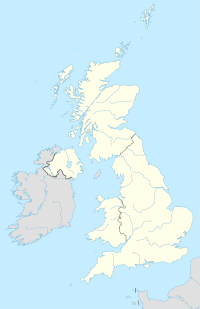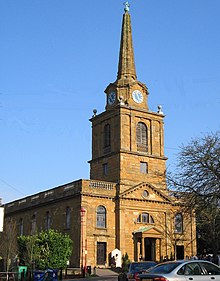Daventry
Coordinates: 52 ° 15 ′ N , 1 ° 10 ′ W
Daventry is a town in the English county of Northamptonshire and the administrative seat of the district of the same name . The population is 22,367 (as of 2001). The place is twin town of Westerburg in Rhineland-Palatinate .
history
Remains of fortifications from the Iron Age and buildings from the time of the Roman Empire were found on "Borough Hill", a 199-meter-high hill in the urban area . Today's Daventry was built around this hill from the early Middle Ages . The name of the place is derived from Daefantreo , a "tree of Dafa". Over the years the spelling and speaking of the name changed - records of 1085 contain the name Daventrei , followed by Dauentry (1124) and Davintria (1200).
In 1255 Daventry was given market rights. Due to its convenient location on one of the main routes between London and Coventry , Daventry gradually took over tasks from surrounding market towns such as Catesby, Fawsley, Flore and Long Buckby. In 1576 the place was given the status of a borough by Queen Elizabeth I , which he kept until 1974 when today's Daventry district was founded.
The Industrial Revolution had little impact on Daventry after the place lost its former convenient location. The Grand Junction Canal , a canal between London- Brentford on the Thames and Braunston near Rugby and now part of the Grand Union Canal , was built between 1793 and 1805 a few kilometers north of Daventry. The London and Birmingham Railway , opened in 1838, was also relocated north and northeast of the city via Long Buckby. Only in 1888 was Daventry connected to the railway network via a branch line that was extended to Leamington Spa in 1895 and closed in the 1960s.
The BBC began building a broadcasting station on Borough Hill in 1923 , which was put into operation in 1925. The BBC World Service program was broadcast from there for decades . Robert Watson-Watt and Arnold Wilkins carried out the first British radar field test there on February 26, 1935 . The broadcasting station was closed on March 28, 1992 by the BBC and is now only partially used for air traffic control .
Until the 1950s Daventry remained a small town, in 1950 about 6,000 inhabitants lived in the place. In the following years, the settlement of various companies such as the ball bearing manufacturer British Timken resulted in strong population growth, so that the population increased to around 20,000 by the mid-1970s.
Daventry transshipment station
In the 1990s, the Daventry International Railfreight Terminal (DIRFT), a transhipment station for combined transport , was built at the junction of the West Coast Main Line between London and Coventry and the M1 motorway . The name of the terminal operated by the Tibbett & Britten company is misleading in that the facility is over ten kilometers north of Daventry. All four rail freight companies in Great Britain, Direct Rail Services (DRS), DB Cargo UK , Freightliner and GB Railfreight , use the DIRFT. The terminal is now one of the largest offshore transshipment stations in Great Britain.
Web links
- Daventry Town Council (English)
- Daventry District Council (English)
- Daventry Express Newspaper (English)
- Daventry International Railfreight Terminal (English)


